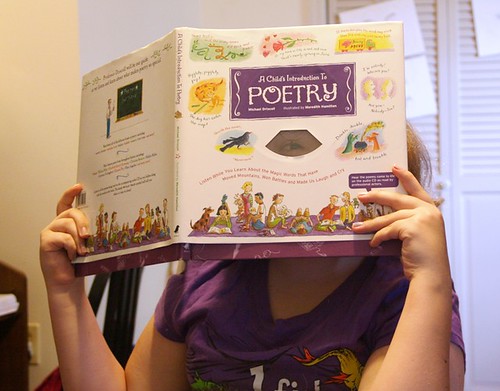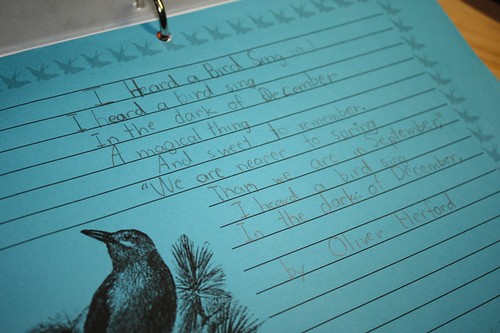We’ve covered two basics so far — grammar and reading. Now let’s talk about a part of language arts that you may consider an “extra” — poetry.
I am going to make a confession on this blog post. I am not a huge lover of poetry. I absolutely would not pick up a book of poetry to read for fun. I prefer to read literature that is more straightforward than poetry is. By nature, I don’t express myself poetically. However, I have always included poetry in Sprite’s language arts curriculum, and she greatly enjoys poetry. Granted, she is much more of a creative thinker than I, but I credit my consistent poetry lessons to her appreciation of the form.

My method of studying poetry is very simple.
My Steps for Studying Poetry (with thanks to Charlotte Mason)
1. Get a poetry anthology that fits your child’s age.
2. Read a poem to your child each day.
3. Ask your child to tell you back what he heard, in other words narrate the poem.
4. Discuss the poem if desired. Ask your child to read the poem occasionally.
5. Periodically (2-4 times monthly) have your child copy a poem into a poetry notebook.
It is truly that simple.
My method is a slight diversion from Charlotte Mason’s method of studying the work of a single poet in-depth for an entire term (much like her suggestions for artist study and composer study which we do follow). For elementary and middle school years, I find that technique too stifling. Instead, we skip around our anthology, choosing whatever poet and whatever form strikes our fancy. Sometimes I choose; sometimes Sprite chooses. My objective is simply to expose her to the language and forms of poetry, and I find that variety works best to achieve my goal.
The beauty of this method is that although our poetry time is very short –ten minutes at the maximum, the daily repetition builds up a wealth of experience with poetry. As a consequence, Sprite is not intimidated by poetry in the least.
Do we skip some days? Sure we do. Do we ever go weeks when poetry is neglected? Yes, that happens. But the general rule is one poem per day. Sometimes I am able to do some crossover into other academic areas with our poetry. Two examples are math and art.
At different times we informally studied poetic devices such as personification, metaphor, simile, and alliteration and discussed those in terms of the poems we read.
My Favorite Poetry Anthologies
- The 20th Century Children’s Poetry Treasury
- Read-Aloud Rhymes for the Very Young
- The Random House Book of Poetry for Children
- Poetry Speaks to Children (Book & CD)
- Classic Poems to Read Aloud
Read Poetry Outloud

Poetry Notebooks
Notebooking has a prominent place in our homeschool, and poetry is included in that. For many years, Sprite’s poetry notebook was a collection of poems which she copied onto notebooking pages (copywork, really). My general practice was to allow her to select one of the poems we had recently studied to add to her notebook.
By copying the poems she is getting these benefits:
- working on handwriting
- focusing on the format of poems
- seeing spellings
- reading advanced grammatical structures
- writing sophisticated vocabulary
- considering figures of speech
From her perspective, she enjoyed making a collection of her favorite poems, many of which she illustrated herself.
Now that Sprite is in middle school (7th grade), I have added a study of poetic forms. We are using A Child’s Introduction to Poetry as our spine and complementing with the free printable notebooking pages at Notebooking Fairy for eleven different poetic forms:
- Villanelle
- Limerick & Nonsense Verse
- Nursery Rhymes
- Narrative Poetry & Haiku
- Lyric Verse & Free Verse
- Pastoral & Sonnet
- Ballad
So now her poetry notebook has pages about different kinds of poems as well as the poems themselves.
As we continue in A Child’s Introduction to Poetry, we will be looking at some of the most famous poets. Probably in eighth or ninth grade I will shift to Charlotte Mason’s recommendation of studying one poet per term. I really like the Poetry for Young People series for this purpose, but we’ll see when we get there.
Do your children enjoy poetry? What have you found to be the best poetry resource? Please share in the comments below.
I totally agree that poetry is something of an acquired taste, especially that which does not rhyme. Kids, however, seem to take to a good rhyme or a silly poem. I certainly do not make enough of an effort to explore poetry on a daily basis. As with all of your posts I am inspired to do more. Thanks, Jimmie.
I think the biggest reason that adults dislike poetry is because poetry gets analyzed too much and beaten to death when we are in high school, so that love we have for it as children is destroyed! I have a post here called “Reading Poetry With Children.” http://smallworldathome.blogspot.com/2009/04/national-poetry-month-reading-poetry.html
I love that lesson plan–so simple, yet it covers all the important parts: understand and connecting with the poem and the poet. 🙂
I ‘want’ to like poetry…and I do a little…my dd loves it, too…i really need to start a different notebook for her and print off more of your pretty pages. What I can’t wait to do is print off this entire series you have written and are writing!
I love poetry and so do my kids….but like you said, I think that regular exposure helps to build that love. I start when they are small with Dennis Lee’s “Alligator Pie” and basic nursery rhymes. By about grade 3, we have a longer poem to memorize as a family that lives on our fridge, and we challenge each other (recent hits have been “Father William”, “In Flander’s Fields” “High Flight”, “The Eagle”) to see who has it memorized the best. Our preschooler has surprised us all by reciting some of the verses verbatim, with sweeping arm gestures!
We are also using A Child’s Introduction to Poetry. We don’t do poetry every day though, just on Thursdays and we memorize 1 poem per month. The next poetry book that we will use is The Poets’ Corner: The one-and-only poetry book for the whole family compiled by John Lithgow. It comes with an audio CD of some of the selections and includes mini-biographies of many poets.